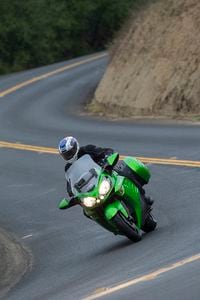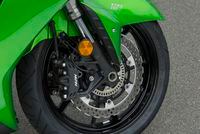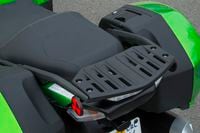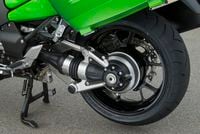Fans of the Kawasaki Concours 14—and those who design and build the beast—are right to feel a little left out of the conversation. After all, the Connie stormed onto the scene late in 2007 (as an ‘08 model) packing a ZX-14-based engine, crisp bodywork, and all the main amenities that sport-touring riders demand: big power, high levels of comfort, shaft final drive, full aero coverage, standard saddlebags.
That’s fine, but this is better: The Connie just gets it on. Its 1,352cc inline-four uses variable valve timing on the intakes to put 132 hp to the rear wheel, which doesn’t sound super impressive until you realize that it’s at or near that figure from 7,700 rpm to 9,400 rpm, and above 120 hp from 7,000 rpm to the rev limiter. All the while, the Zed-X engine maintains prodigious torque—the last one tested on our dyno made better than 80 pound-feet of torque from 4,000 to 8,500 rpm. Numbers don’t do it justice. Few engines are as flexible or as entertaining.
Six years ago, the Connie was the sport-touring-class beast of choice, sending the Honda ST1300 and Yamaha FJR1300 back to school. We called it the Best Touring bike of 2008 and 2009. And when we pitted it against the tidier sport-touring rigs—BMW’s K1300S, Honda’s VFR1200F, Triumph’s Sprint GT—the Kawi clobbered ‘em all ( see the 2011 MC Comparo HERE ). “Other bikes can run quicker here or feel more capable over there, but only one is very, very good at all the things that makes a big, fast sport-touring bike truly great. All hail the winner: Kawasaki’s Concours 14,” we said in 2011.
That was a year after the Connie’s last update of mention: a host of small changes that dramatically reduced heat transfer to the rider plus the addition of ABS and traction control as conjoined options. All that for 2010. Since then? Nada, just different colors.
So like the character from “Monty Python and the Holy Grail” who says, “I’m not dead yet!” here’s Kawasaki refining the Concours 14 so you won’t forget it among the newer and more elaborately equipped competition.
None of the updates promises to vault the now-very-good (as opposed to comparison-test-winning) Connie to superstardom. For 2015, there’s a slightly shorter first gear ratio, low-resistance steering-stem seals, a reworked saddle, and a new windscreen. Benefits are as expected: easier getaways, reduced low-speed steering, improved comfort while reducing the “leg over” height of the seat, and better aerodynamic coverage for the rider and passenger. The new screen is the same size as before but has a two-position (plus closed) vent at the base.
One change has the potential to materially improve the Connie, though, and that’s a revision to the bike’s standard linked-braking setup. This is a bi-directional linking system, applying a little rear brake when you use only the front lever, and vise versa. Kawasaki says, “the system links the front and rear brakes for the most effective brake force distribution.” Via the on-screen (black-and-white LCD…so 2008!) you can choose one of two settings based on anticipated load. Standard is for sportier riding and provides less effective linkage. “High-Combined,” designed for two-up touring, has more aggressive linkage in both directions—front to rear and rear to front.
That’s all fine, but our longstanding gripe is the way the linkage system operates. If you gently apply both front and rear brakes, as when you’re coming to a gradual stop, the system changes from none (or very low) rear-to-front biasing to a much higher state. The sensation is like you’d just tapped down a little harder on the brake pedal. When you didn’t. Even the smoothest riders had difficulty anticipating the threshold and making totally seamless stops.
Great news, everybody, the modifications did the job. In the standard mode, you can hardly feel the brake linking, and the system is totally linear to lever or pedal input—and it most certainly was not like this before. That change alone makes the Connie much easier to ride smoothly at low speed. Reactions in the High-Combined mode are as before, and favor a lot of rear brake when you apply just the front; the idea is to reduce chassis pitching for two-up riding, which in turn helps cut back on helmet bashing between rider and passenger.
We rode on a dreary, wet day in California—yes, it does eventually rain here—with limited time at speed, so assessing the new ported windshield is a little harder. Previously, when the screen was in the full-up position, the rider experienced a significant amount of “head push” from behind. No longer. Opening the port allows a large volume of air to run up the rider’s side of the windscreen, reducing turbulence and this head-push phenomenon. At the expense of admitting rain to the cockpit, of course, but not a lot of it.
We also didn’t ride quite long enough to fully evaluate the new seat, which is notably, though not radically, thinner at the tank junction. It feels immediately comfortable and natural, and seems firm enough to be fine for the longer haul.
A day spent splashing around on the Connie reminds us how competent it really is. As mentioned, the engine is a gem, doling out impressive power throughout the rev range and making the very tall gearing work despite its heft—690 pounds claims Kawasaki. (And we concur: The last one we tested weighed 690 pounds full of fuel on our scales.) Steering is fine, not as quick as, say, the new BMW R1200RT’s or Triumph’s Trophy SE, but in line with the Yamaha FJR1300. So let’s call it solid and predictable rather than inspiring or racy.
Kawasaki positions the Connie as a sportier sport-touring machine than its obvious competitors. It is, for example, much more stiffly sprung than Yamaha’s FJR1300, which edges toward the touring side of the ST balance beam, and the Connie has a slightly more aggressive riding position, with the handgrips a little closer and a little lower than you’d find on the Yamaha. So, yes, the Connie is biased toward the sportier side of the ST scale, but it’s still not terribly light on its feet.And yet the Kawi is also commendably smooth and refined in most ways, able to tick off the miles despite the (now) glaring absence of cruise control and, perhaps, a virtual Pachinko machine in the instrument cluster. Only suspension compliance holds the C14 back dynamically. Compromises to give the bike a sporty feel also give it a slightly rough ride. True, the bike handles small bumps well, and never crashes through on the larger ones, but those pesky mid-amplitude bumps give the suspension fits. An FJR glides over the same pavement that has the Connie pilot doing the bobble-head-doll thing.
So let’s call this what it is: a mild, very mild update on a machine we’ve come to appreciate over the years. Do these alterations put it back to the head of the class? No, they don’t. But the Connie also isn’t playing for the same kind of dough, either. At $15,499, the 2015 Concours 14 ABS undercuts everything in the class. (Incidentally, the 2014 Connie started out at $16,199 but its MSRP was reduced to $15,499 during the year. Plus, there are dealer incentives of $1,000 still running on the ’14 bike.) Yamaha’s non-ES version of the FJR clocks in at $15,890, while Honda’s two offerings (neither of which is a current 2015 bike, by the way) are $15,999 for the luggage-less VFR1200F and $18,230 for the ST1300. BMW’s R1200RT is a natural cross-shop, too, and while it ostensibly starts at $17,700, we’ve been told by BMW that relatively few base models will be imported; realistically, this is a $20K motorcycle. A bit ironic, isn’t it, that the sport-touring machine that once dominated the category is now the value leader?































/cloudfront-us-east-1.images.arcpublishing.com/octane/G4MG6OUCJNBSHIS2MVVOTPX65E.jpg)
/cloudfront-us-east-1.images.arcpublishing.com/octane/IIGGWFOTOJGB7DB6DGBXCCMTDY.jpg)
/cloudfront-us-east-1.images.arcpublishing.com/octane/QSTCM6AVEZA5JJBUXNIQ3DSOF4.jpg)
/cloudfront-us-east-1.images.arcpublishing.com/octane/U4I7G625B5DMLF2DVIJDFZVV6M.jpg)
/cloudfront-us-east-1.images.arcpublishing.com/octane/B6XD6LS6IVCQPIU6HXDJSM3FHY.jpg)
/cloudfront-us-east-1.images.arcpublishing.com/octane/ICL63FEDDRDTTMINYICCEYGMDA.jpg)
/cloudfront-us-east-1.images.arcpublishing.com/octane/FCGZHQXRBZFLBAPC5SDIQLVF4I.jpg)
/cloudfront-us-east-1.images.arcpublishing.com/octane/WNOB6LDOIFFHJKPSVIWDYUGOPM.jpg)

/cloudfront-us-east-1.images.arcpublishing.com/octane/X33NU3E525ECRHXLNUJN2FTRKI.jpg)
/cloudfront-us-east-1.images.arcpublishing.com/octane/6KKT5NNL2JAVBOXMZYS5ZO76YA.jpg)
/cloudfront-us-east-1.images.arcpublishing.com/octane/J5RKG5O455GMPGQRF2OG6LRT7A.jpg)
/cloudfront-us-east-1.images.arcpublishing.com/octane/GX2CIZKQVRH2TATDM26KFG2DAE.jpg)
/cloudfront-us-east-1.images.arcpublishing.com/octane/ZWIDYSAKQZHD5BHREMQILXJCGM.jpg)
/cloudfront-us-east-1.images.arcpublishing.com/octane/CYUHJZCTSJCH3MRAQEIKXK7SCQ.jpg)
/cloudfront-us-east-1.images.arcpublishing.com/octane/LKOFINY56FCXJCANJ5M7ZDQUBY.jpg)
/cloudfront-us-east-1.images.arcpublishing.com/octane/4NBPDACMWJH63JQYJVK3QRBDZI.jpg)
/cloudfront-us-east-1.images.arcpublishing.com/octane/KKHQHRR3FJGX7H2IPU6RALMWG4.jpg)

/cloudfront-us-east-1.images.arcpublishing.com/octane/5IOFS5JAE5FOXMNA23ZRAVVYUU.jpg)
/cloudfront-us-east-1.images.arcpublishing.com/octane/CGXQ3O2VVJF7PGTYR3QICTLDLM.jpg)

/cloudfront-us-east-1.images.arcpublishing.com/octane/OQVCJOABCFC5NBEF2KIGRCV3XA.jpg)
/cloudfront-us-east-1.images.arcpublishing.com/octane/OPVQ7R4EFNCLRDPSQT4FBZCS2A.jpg)